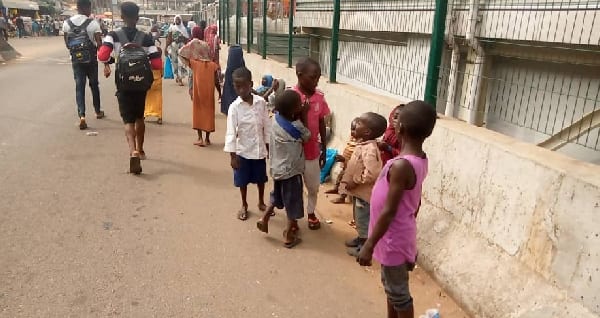Beneath the Surface: Unraveling the Cycle of Abuse and Crime Among Child Beggars
Undoubtedly, the vicious cycle of abuse and criminality that befalls street children beggars is a terrible and upsetting reality that impacts a great number of weaker children worldwide. This vicious loop frequently consists of a number of interrelated elements that exacerbate their misery and provide formidable obstacles to escaping their horrible situation.
The situation is not exclusive to any one nation rather, it is prevalent throughout the world. The issue of illegal beggars, who frequently come from various parts of Africa, Afghanistan, Yemen, and other regions, is a complicated and difficult one that many Arab countries must deal with. Destinations in Southeast and South Asia, such as Thailand, India, and Indonesia, have huge number of beggars. And yet, one thing is for sure: Japan is the only nation on World where the percentage of the homeless is nearly zero. Many worldwide forums and organizations are actively attempting to address the problem, yet despite their efforts over many years, the problem persists.
This is a summary of how this cycle usually progresses:
Poverty and Vulnerability: A large number of teenage beggar originate from low-income households that find it difficult to provide for their members’ basic necessities, including food, housing, and education. They are vulnerable to exploitation because of this weakness.
Physical and mental Abuse: Those who handle or control child beggars frequently subject children to physical and mental abuse. The abuse can take many different forms, such as beatings or threats, which keep kids in a state of perpetually terror and engagement.
Forced Begging: Adults or criminal networks that take advantage of children’s pathetic appearance may force, traffic, or even kidnap them in order to force them to beg. Many times, they must endure long hours of begging under tough situations.
Dependency Cycle: Children who persist in begging and give their managers a portion of their earnings do so at risk of becoming entangled in a cycle of dependency. Their wages are frequently taken away from them, leaving them with little left over to exist and increasing their dependence on others who take advantage of them.
Criminal Activities: Child beggars may occasionally be forced into committing crimes including stealing, pickpocketing, or even drug trafficking. Frequently, the networks that govern these activities also organize them.
Read Full: Poverty and Inequality in the world
Lack of Education and Development: Being engaged in begging and criminal activities denies these children access to education, proper nutrition, and healthy development. This perpetuates a cycle of limited opportunities and reinforces their vulnerability.
Social Stigmatization: Child beggars often face social stigmatization due to their appearance and association with begging. This stigma can isolate them from mainstream society and prevent them from seeking help.
Limited Rescue and Support: While there are organizations and initiatives that work to rescue and rehabilitate child beggars, the scale of the issue often exceeds available resources. Lack of proper systems for their protection and rehabilitation further perpetuates the cycle
Break The Cycle
- It need a variety of approaches to break this cycle, one that attends to the urgent needs of kids beggars as well as the underlying causes of their exploitation. It includes:
- Recognizing and removing children from circumstances where they are being exploited is essential for intervention and rehabilitation. They require access to trauma counseling, medical care, and secure shelters.
- Education and opportunity for skill development: Giving kids access to high-quality education and training can help them break free from the cycle and create better lives for themselves in the future.
- Strengthening anti-child exploitation and anti-human trafficking legislation and making sure they are properly enforced can discourage criminals from taking advantage of innocent youngsters.
- Encouraging lawmakers to take action and raising public awareness of the problem can result in a stronger social consensus in favor of vulnerable children.
- In order to address the core reasons, it is frequently necessary to help struggling families, establish social safety nets, and create networks of community support.
Organizations and Forums are actively working to address the issue
1. United Nations (UN): The UN has established several agencies and programs that focus on migration, human rights, and human trafficking. The International Organization for Migration (IOM) and the United Nations Office on Drugs and Crime (UNODC) are involved in combating human trafficking and providing support to migrants.
2. International Labour Organization (ILO): The ILO addresses labor exploitation and forced labor, which can be connected to exploitative begging. They work to develop international labor standards and promote decent work conditions.
3. UNICEF: The United Nations Children’s Fund (UNICEF) focuses on protecting the rights of children, including those vulnerable to exploitation, trafficking, and begging. They work to provide education, healthcare, and support to children in need.
4. European Union (EU): The EU has established measures to combat human trafficking, improve migration policies, and promote integration. The EU Anti-Trafficking Coordinator works to coordinate efforts across member states.
5. Council of Europe: The Council of Europe has developed the Convention on Action against Trafficking in Human Beings, which includes measures to prevent human trafficking, protect victims, and prosecute perpetrators.
6. Global Compact for Safe, Orderly and Regular Migration: Adopted by the UN in 2018, this global compact aims to improve international cooperation on migration issues, including addressing the vulnerabilities of migrants and preventing exploitation.
7. NGOs and Civil Society: Numerous non-governmental organizations (NGOs) are actively engaged in combatting human trafficking, supporting migrants, and advocating for policy changes. These organizations often work directly with affected individuals, providing shelter, legal assistance, and rehabilitation services.
8. Research and Data Collection: Many international organizations conduct research and collect data on human trafficking, exploitation, and migration trends. This data is crucial for shaping policies and interventions.
9. Awareness Campaigns: International organizations often run awareness campaigns to educate the public about the realities of human trafficking, forced labor, and exploitation, encouraging individuals to report suspicious activities and support efforts to combat these issues.
10. International Agreements and Conventions: Countries around the world have ratified various international agreements and conventions related to human trafficking and exploitation. These agreements provide a framework for cooperation and action.
Governments, NGOs, communities, and society as a whole must work together to address the cycle of abuse and crime for child beggars.




